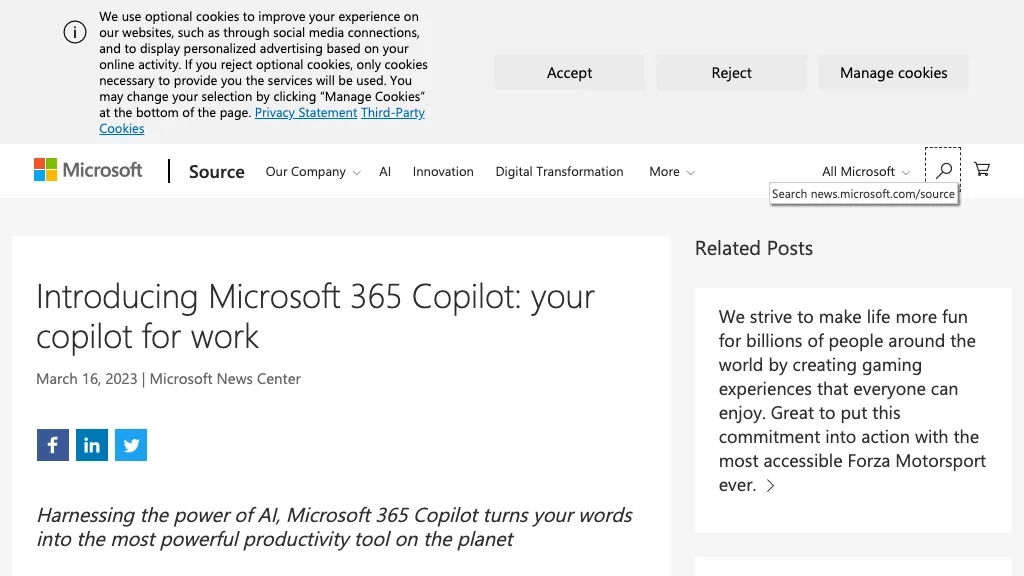What is Microsoft 365 Co-pilot?
Microsoft 365 Co-pilot is a new AI tool leveraging large language models and integrates them with business data from Microsoft 365 applications to create an even more powerful tool that will augment creativity and help users develop new skills. It works seamlessly within apps like Word, Excel, PowerPoint, Outlook, and Teams. Co-pilot introduces a business chat feature to pull data from numerous sources into one place to summarize chats, emails, and project plans. Enterprise-ready: It has adhered to all the stringent security, compliance, and privacy standards that Microsoft has set.
Key Features & Benefits: Microsoft 365 Co-pilot
The features of Microsoft 365 Co-pilot range from preparation and creation of diverse documents, presentations, the management of calendars, to providing insights on the basis of chat activities. A few of the features are listed below:
-
Reports generation:
Providing detailed automatically generated reports. -
Content suggestions:
It provides recommendations for enhancing documents and presentations. -
Scheduling assistance:
Assists in managing calendars and efficient meeting scheduling. -
Chat activity insight:
It provides valuable insights based on interactions via chat. -
Summarizes email and plan data:
This condenses information from emails and project plans into a digestible format for quick comprehension.
These features represent value based on a number of beneficial aspects, such as increasing productivity by streamlining workflows for fast and informed decision-making. The value proposition of Microsoft 365 Co-pilot remains in how this new technology fits smoothly with the current set of applications in Microsoft 365, assembling a cohesive user experience together.
Use Cases/Applications of Microsoft 365 Co-pilot
Microsoft 365 Co-pilot is flexible and fits into any situation, making it relevant for a wide array of business verticals. Specific use cases of the tool include but are not limited to:
-
Document creation automation:
Users can create documents much faster, with less manual input. -
Data summarization in business chat:
Summarizes complex data for easier communication and comprehension. -
Upskilling users through personalized recommendations:
Offers customized suggestions that can help users enrich their skills.
Co-pilots within Microsoft 365 are going to benefit educationally, in the business arena, and through professional services. For instance, it can be used in schools to ease administrative work or improve project management and team collaboration in businesses.
Using Microsoft 365 Co-pilot
To get your feet wet with Microsoft 365 Co-pilot, follow these steps in a pretty easy setup:
-
Access to Microsoft Co-pilot 365:
Open the application where you want to work, like Word or Excel. Log into your Microsoft 365 account. -
Activate Co-pilot:
Activate Co-pilot from the toolbar or from the settings. -
Follow-on Prompts:
Co-pilot will show on-screen prompts and suggestions regarding whatever you may be doing. -
Feature Utilization:
Take advantage of various features like generating reports, content suggestions, or scheduling for assisting you to go about your task. -
Edit:
Read through Co-pilot output, and edit where necessary.
As good practice refresh your Microsoft 365 applications from time to time, and try the new features and improvements Co-pilot will offer in the near future.
How Microsoft 365 Co-pilot Works
Advanced large language models are bound together with the business data of Microsoft 365, empowering Co-pilot to capture and process complex information. The outputs will be highly accurate and relevant to the users. The key technology in back-end systems includes sophisticated algorithms and machine learning models, which improve themselves with user interactions and response analyses.
It involves data gathering from disparate sources, processing the same through the AI models, and presenting it in a user-friendly fashion within the Microsoft 365 applications. This would ensure that whatever insights are actionable will be provided to users in time and without their having to work their way through various different platforms.
Pros and Cons of Microsoft 365 Co-pilot
Like any tool, Microsoft 365 Co-pilot has benefits and potential drawbacks. A quick overview is given below:
Pros
- Improved productivity: Automates routine tasks so that users can focus on more strategic activities.
- Seamless integration: Works well within existing applications of Microsoft 365.
- Personalized suggestions: It provides personalized suggestions based on user behavior and preferences.
Possible Cons
- Learning curve: New users may require some time to understand and utilize all features.
- Dependency on quality of data: Results are only as good as the data fed into it.
On the whole, users’ reactions to it have been quite good; the tool really does help reduce much of the workload and bring efficiency up many notches.
Conclusion about Microsoft 365 Co-pilot
Microsoft 365 Co-pilot is a powerful AI tool whose aim is to drive more productivity and creativity by infusing those qualities across many applications. Capabilities like document creation automation, coupled with personalized suggestions embedded into Microsoft 365, make it a worthwhile addition for any professional, student, and business. With new inventions that Microsoft is known for, users will get more advanced features and enhancements in the near future.
Microsoft 365 Copilot FAQs
What is Microsoft 365 Co-pilot?
It is the AI model to be combined with large language models and Microsoft 365 business data to fabricate productivity and ingenuity.
How do I enable Microsoft 365 Co-pilot?
This can be enabled in the toolbar or setting menu of a given Microsoft 365 application.
Which industries will benefit most from Microsoft 365 Co-pilot?
The education, commercial, and professional services sectors are just a few examples of great beneficiaries for this tool.
Is Microsoft 365 Co-pilot secure?
Yes, Microsoft uses its integrated approach to security, compliance, and privacy to build the platform.










